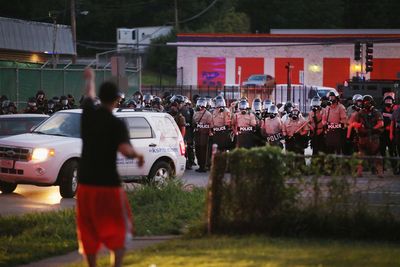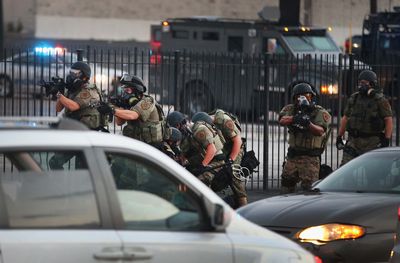
PHOTOS: GETTY
The Federal Bureau of Investigation will investigate the fatal shooting by police of 18-year-old Michael Brown in suburban St. Louis, according to a statement by Attorney General Eric Holder released by the Justice Department.
Meanwhile: The St. Louis metropolitan region has been rocked by three days of protests after the unarmed, Black teenager was killed by a Ferguson police officer on Saturday, August 9. "Officials have so far declined to identify the police officer who shot Mr. Brown or disclose his race. The officer was put on administrative leave," reports The New York Times.
On Monday night, police officers using tear gas and rubber bullets tried to disperse the crowd of mostly African-Americans, who had been gathering through the day under the hot sun. The protesters questioned the role that race — and simmering tensions between residents and the Police Department — may have played in the killing of Michael Brown, 18, who was to start college this week.
The standoff lasted for more than an hour, with about a dozen men approaching officers with their hands up saying, “Don’t shoot me.” At least 100 police officers were on the scene, shining bright lights into the crowd and telling people to return to their homes.

The population of Ferguson has changed dramatically ... but the suburb's power structure has not.
Ferguson, a city of 21,000 northwest of St. Louis, has shifted substantially over the last decade, with blacks, once a minority, now making up two-thirds of the residents, after many white families moved out to surrounding suburbs. The town’s leadership and the police have remained predominantly white. In 2013, the suspension of a black superintendent of schools by an all-white school board stirred protests. And the Justice Department has a continuing investigation into racial disparities in legal representation for juveniles in Family Court.
The police maintain the unarmed teenager struck a police officer and tried to grab the officer's gun. Numerous witnesses have disputed the official account and describe an execution, reports ColorLines.
Dorian Johnson was walking down the middle of the street in Ferguson, Missouri, with his friend Michael Brown on Saturday—just moments before Brown was shot and killed by a still unnamed police officer. Johnson says that police officer began cursing at them and emerged from the car with his weapon drawn. He says he remembers no fewer than seven shots fired. He recalls that Brown’s hands were in the air as the officer fired.
MSNBC is reporting that Johnson’s attorney, Freeman Bosley, says that police declined the opportunity to speak with Johnson during their investigation.
Johnson has told several media outlets that Brown did not strike the officer. Johnson says the officer grabbed Brown by the throat and then unloaded his weapon.
A second eyewitness also disputes the official claim. "The witness 'did not see Michael Brown struggling with the police officer inside his car at any point,' [said St. Louis NAACP President Adolphus Pruitt]. "They did witness the incident from the time it started from the time of the initial stop by the police car," reports the St. Louis Post Dispatch. The FBI will soon interview this new witness, according to reports.
Oscar Grant, Eric Garner, Amadou Diallo, Kimani Gray, Trayvon Martin, Michael Brown, Renisha McBride, Jordan Davis ... Keep moving, folks. Same story, different day. Nothing to see here except an unarmed Black person hunted like an animal and brutally killed.








